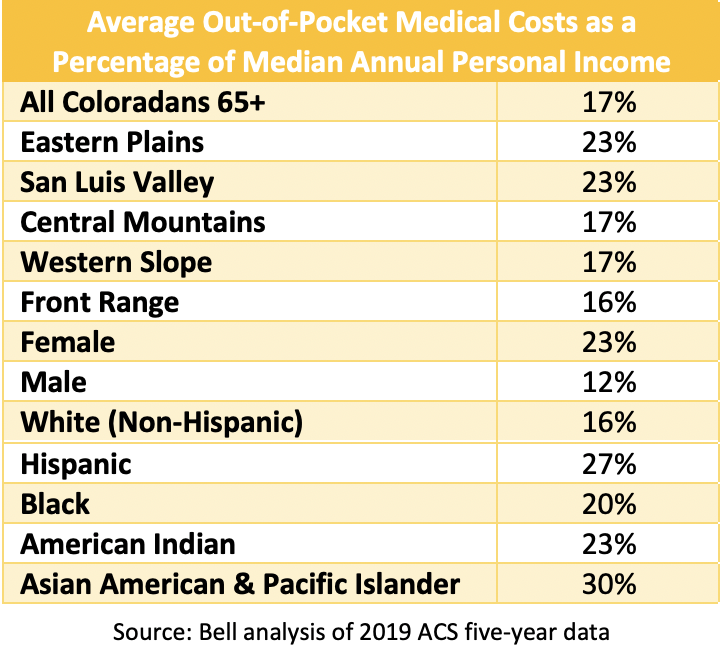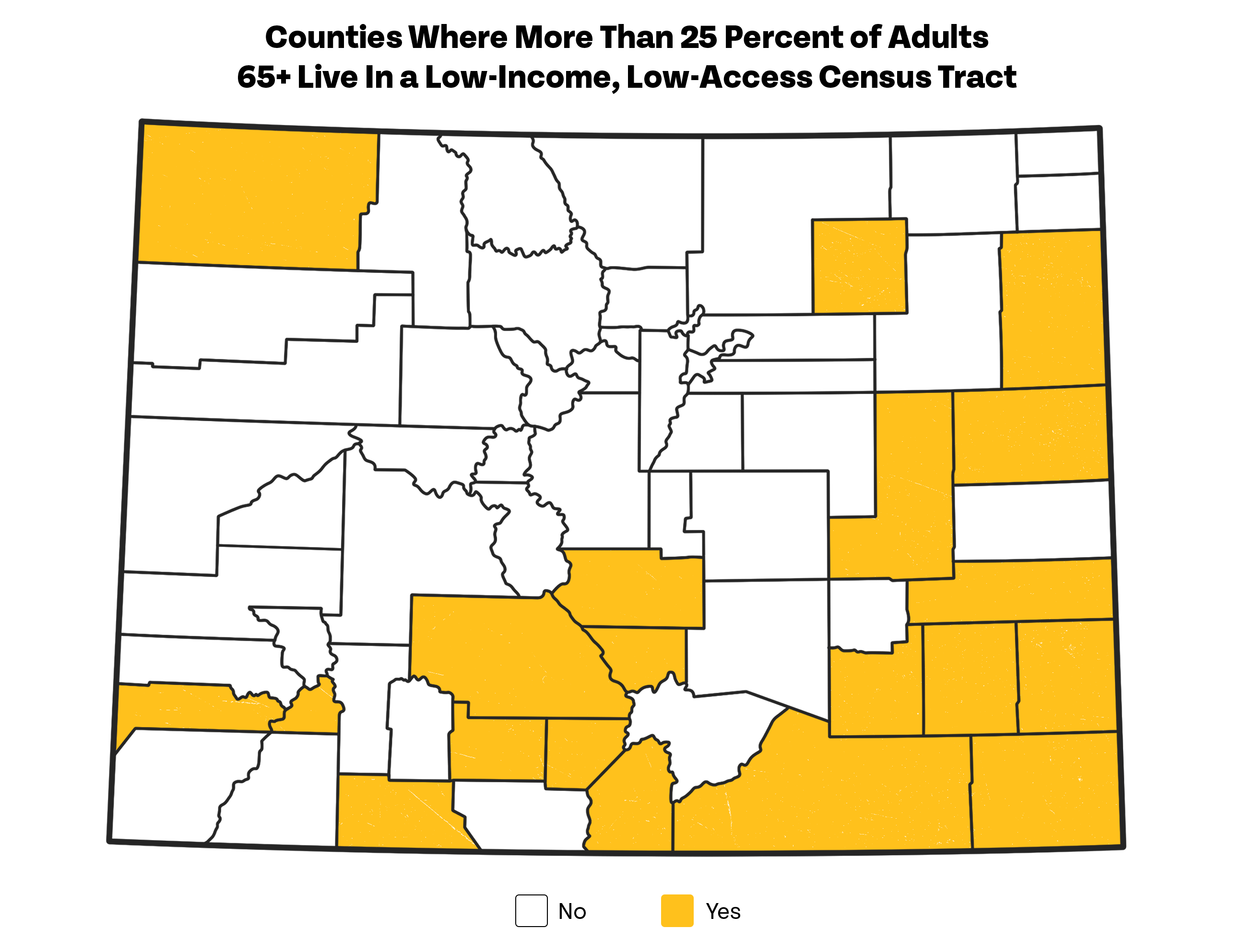State of Aging: Health
State of Aging: Health
Signifying its importance, health and preventative care is one of the six major focus areas explicitly called out in our Actionable Aging Policy Agenda. While creating the agenda, collaborators and partners regularly cited good physical, oral, and emotional health as critical linchpins in maintaining happy, fulfilling lives. To better understand the overall health of older Coloradans, we explore the self-reported health statuses of individuals 65+ across our state, and a variety of measures related to affordability, access, and preventative care.
The Data
Self-reported health status is perhaps the most obvious indicator of an individual’s health and well-being. The charts below show how older Coloradans assess their own general, mental, and oral health.
Beyond the Topline
In examining the underlying factors which contribute to the self-reported health status of older Coloradans, we dug into several important issues including cost of care, access to care, and access to preventative care.
Cost concerns are a well-recognized barrier to health and well-being, and an inability to afford care can lead to skipping needed medical services. As can be seen below, this is a reality for some older Coloradans.
Insurance can play a significant role in reducing health care costs. Importantly, different types of insurance provide varying levels of coverage and cost assistance. As seen below, insurance status and type differ for Coloradans 65 and older.
Even with insurance however, medical care often requires some out-of-pocket costs, for example, to cover premiums, deductibles, or copays. As seen below, these out-of-pocket costs can take up a sizable portion of older Coloradans’ annual personal income.
Finally, preventative care is essential to catching and treating small problems before they become serious or debilitating to one’s health. In addition to regularly seeing a doctor, especially for preventative care, an adequate amount of food is critical to general well-being. Unfortunately, as seen below, cost can be a prohibitive factor in older Coloradans’ ability to eat enough food.
Major Takeaways From the Data
While nearly all older Coloradans report having medical insurance, the percentage drops to less than 55 percent when asked about dental insurance. This lack of insurance likely plays a role in the high number of older Coloradans who skip dental care due to cost concerns. Concerningly, this confluence of factors is a likely contributor to worse self-reported oral health outcomes for older Coloradans.
While older Coloradans have health coverage from a variety of sources, Medicare remains, far and away, the most prominent insurer. This reality must play a role in considerations of how to make heath care more affordable and accessible for older Coloradans.
Systems & Levers for Progress
As shown above, there are tremendous health disparities amongst older Coloradans, driven in part by differential abilities to afford and access care. By investing in both new and existing systems which support health care affordability, affordable and accessible access to food, and culturally appropriate care, we can foster stronger health outcomes for older Coloradans.
Prohibitively high costs of care can contribute to worse health outcomes among older Coloradans. As shown above, Medicare is the most prevalent form of health coverage for older adults, making it a promising lever for reducing costs. Notably, two important adjustments to this program could increase affordability and support better health.
- Increasing coverage: Original Medicare (which excludes supplemental Medicare Advantage plans), does not cover a number of important health services, including: most dental services, glasses and contacts, hearing aids, supportive foot devices, and home safety items. Increasing coverage for these services would play an important role in increasing affordability.
- Lowering coinsurance for covered services: Most services covered through Medicare require coinsurance payments of 20 percent of the Medicare-approved amount. Lowering this threshold, especially for older adults with low incomes, could make a difference in whether individuals seek needed care.
Accessible, affordable food is essential for health. However, as seen above, a significant number of older Coloradans struggle to find enough to eat. The Supplemental Nutrition Assistance Program (SNAP), also commonly known as food stamps, is the largest program supportive of food access in our state, and is an essential resource for many older Coloradans.
Transportation challenges add another layer of complication to achieving food security for older Coloradans. For those with fewer mobility options, even short distances to a grocery store can pose a significant barrier. These transportation challenges are often more acute for older Coloradans with lower incomes. Concerningly, as seen below, a significant number of older adults in Colorado both live in low-income communities and lack nearby grocery stores.
Importantly, these issues of affordability and access are solvable with the systems we have in place. By using the following levers, we can support greater food security for older Coloradans:
- Area Agencies on Aging: Colorado’s Area Agencies on Aging (AAA) constitute a comprehensive, statewide network of community-based nonprofit organizations. Food and transportation services are among the many, many services and supports offered by these agencies. You can read more about how our state can better track the progress of and support for this network on the Community of Choice tab.
- Maintaining the value of SNAP benefits: Maximum SNAP benefits are set by the federal government. Though benefits are usually adjusted on an annual basis, these changes are often minimal. This raises concerns about whether we’re making the changes necessary to ensure benefits keep up with growing prices and costs of living. We can track the strength of this program in the coming years by examining if benefits grow in tandem with inflation, and food and other living expenses.
In conversations with advisory group members, ensuring the availability of and access to culturally appropriate health care was a regularly cited concern. Concerningly, the absence of this type of care has real, detrimental impacts on older Coloradans’ health and well-being. Problematically, little concrete data exists to measure both the need for and availability of these type of care.
Despite these data gaps, several overarching needs and opportunities emerged from conversations with partners. Based upon feedback from advisory group members, in the coming years, we can measure Colorado’s progress on this issue by examining how and whether our state:
- Creates a centralized and trusted location for consumers to find information about if providers offer culturally and linguistically appropriate care and have the physical equipment needed to support those with disabilities. Currently, no centralized system exists to offer this information, making it difficult for individuals to find providers who meet their needs. Too often this current system leads to an over-reliance on informal networks and word of mouth to find needed care.
- Adopts a more universal cultural competence certification for providers. Providers can, and often do, receive cultural competence certifications. The attainment of these qualifications are advertised, in part, to attract new clients. However, the lack of clarity about the curriculum and design behind these certifications can make it difficult for patients to find meaning in these designations.
- Develops clearer support for older Coloradans with intersectional identities. The minimal information and resources available to older Coloradans in need of culturally appropriate care becomes even more limited for those with intersectional identities, for example a Latinx, transgender woman, who uses a wheelchair. For these individuals, it’s not simply enough to find a provider they trust enough to be open with about their identity as a transgender woman. Instead, they also need to find a professional who has the right physical equipment to accommodate their wheelchair and understand her identity as a Latina.


